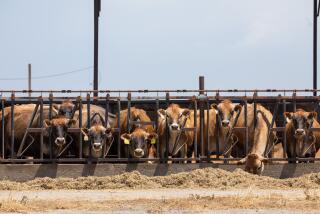New Items Spread Dairy Message
One of the food industry’s biggest success stories is the manner in which margarine became a household staple in the years after World War II. Convenience and price certainly played a part in the spreadable topping’s emergence from a laboratory curiosity.
However, marketing and industry analysts say part of the reason for margarine’s increasing presence in refrigerators was that the dairy industry did little to compete with the threat posed by the imitation product until after the sales damage had already been done.
Today, margarine outsells butter by considerably more than 2 to 1. On a per capita basis, for instance, margarine consumption in this country is at 10 pounds annually, compared to a mere four pounds for its natural counterpart.
Even more troublesome for dairy interests is that only half of all butter consumption is in the home, with the remainder occurring in restaurants. As a result, margarine outsells butter in supermarket purchases by an even larger ratio of about 5 to 1.
Now, the dairy industry hopes to win back some of its dramatic losses with a new product developed exclusively for the California Milk Advisory Board. The latest effort, Slim & Natural Spread, is a hybrid that will fall somewhere between butter and margarine while still being a 100% dairy-based item.
A major part of Slim & Natural’s appeal is that it contains 50% fewer calories and 50% less sodium than similar servings of either margarine or butter. The spread also has a delicate dairy taste that is more subdued than the saltier, oilier margarines.
The product is made by circumventing the process typically used to create butter, which involves separating fat from the liquid in cream. In this case, dry milk solids are added to cream. The addition of the solids takes place instead of any fat separation. The new mixture is then blended to form Slim & Natural, according to Adri G. Boudewyn of the California Milk Advisory Board.
Aggressive Strategy
The latest table spread, currently undergoing test marketing in Bakersfield, is part of an aggressive strategy embarked upon by this state’s milk board. The dairy group plans to introduce a variety of food items in the next several years to expand its product line and ultimately sell more milk.
“We have decided to do more than sell just three milks, butter and cheeses,” Boudewyn said. “If we can bring out six or seven new products made from milk, then we’ll be set for the next 20 years.”
Also in test marketing in the San Diego area is Vital 15, a fortified milk, formulated primarily for women, which contains 100% of the government-recommended daily allowance for calcium along with 14 other nutrients and minerals in two (eight-ounce) servings.
In both cases, the board is waiting to see whether the new products further reduce sales of butter and milk, respectively, rather than improve the overall category.
“If Slim & Natural cannibalizes (reduces) butter sales, then we are out of it, but if it doesn’t, then we are in. The same goes for Vital 15,” he said.
Each introduction is made with a heavy emphasis on advertising and in-store demonstrations in order to explain the new technologies to consumers.
In the meantime, the milk board will license dairy companies from around the state to manufacture the product and will also assist with providing the packaging, labeling and promotion. The only requirement is that each product contain only California milk.
Some of the other items the board has planned include a butter oil, a fermented milk, pasta toppings and a South American drink called batida , which is milk flavored with tropical fruits.
Springing Forward Early--Thoughts of summer are sometimes difficult to conjur during the heart of the holiday season. Yet, one food-related industry is eagerly anticipating the next seasonal change.
Previously enacted federal legislation calls for daylight-saving time to begin this year on the first Sunday in April, or three weeks earlier than has been the case. The move has the Barbecue Industry Assn. sizzling with anticipation.
The trade group estimates that the additional evening daylight hours resulting from the switch will be a boon for charcoal briquette sales. In a recent newsletter, the New York-based association reported that the time change should bring an additional $24 million in total revenue to the industry.
To make consumers aware of the earlier seasonal start, the group is encouraging supermarkets to begin featuring barbecue promotions beginning April 1.
Drinking’s Flawed Protection--Popular belief, and even a few research studies, have seemed to indicate that those who drink are less likely to be injured in automobile accidents than are other nondrinking drivers or passengers.
Such apparently is not the case, according to a study conducted by the University of North Carolina’s School of Public Health and released earlier this year.
The report reviewed data from automobile crashes in North Carolina during a five-year period. The information included data on more than 1 million drivers.
After analyzing the statistics, the research team led by Patricia F. Waller found that those drivers who had consumed alcohol were much more likely to be injured or killed than those who were not drinking.
In fact, the increased risk was greatest in least-damaging accidents, according to a report of the project in the Journal of the American Medical Assn.
The study found that fatalities among drivers in accidents who had consumed alcohol was 3.85 times greater than for those who were sober. Surprisingly, the risk increased even further for the lower-speed, less-damaging crashes where fatalities occurred 4.5 times more often for alcohol-using drivers than for nondrinkers.
“These findings do not support the widespread belief that alcohol is protective against injury, but rather indicate that alcohol increases vulnerability to injury in any given crash,” the report stated.
More to Read
Eat your way across L.A.
Get our weekly Tasting Notes newsletter for reviews, news and more.
You may occasionally receive promotional content from the Los Angeles Times.










